Search results for: 'form'
-
 Protogeld in Form einer Pfeilspitze
Protogeld in Form einer PfeilspitzeVormünzliche Geldform aus dem 7. - 6. Jh. v. Chr., geprägt in Istros, sehr guter Zustand.
Price: on request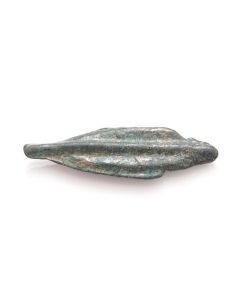 Protogeld in Form einer Pfeilspitze
Protogeld in Form einer PfeilspitzeVormünzliche Geldform aus dem 7. - 6. Jh. v. Chr., geprägt in Istros, sehr guter Zustand.
Price: on request Protogeld in Form einer Pfeilspitze
Protogeld in Form einer PfeilspitzeVormünzliche Geldform aus dem 7. - 6. Jh. v. Chr., geprägt in Istros, perfekte Erhaltung. Länge 44 mm.
Price: on request Protogeld in Form einer Pfeilspitze
Protogeld in Form einer PfeilspitzeVormünzliche Geldform aus dem 7. - 6. Jh. v. Chr., geprägt in Istros, guter Erhaltungszustand. Länge 32 mm.
Price: on request Seltenes skythisches Protogeld in Pfeilform
Seltenes skythisches Protogeld in PfeilformVormünzliche Geldform aus dem 7. - 6. Jh. v. Chr., Schwarzmeerregion, sehr guter Zustand.
Price: on request Seltenes skythisches Protogeld in Pfeilform
Seltenes skythisches Protogeld in PfeilformVormünzliche Geldform aus dem 7. - 6. Jh. v. Chr., Schwarzmeerregion, sehr guter Zustand.
Price: on request Hochgradig seltenes skythisches Protogeld in Pfeilform
Hochgradig seltenes skythisches Protogeld in Pfeilform7. - 6. Jh. v. Chr., Schwarzmeerregion, sehr guter Zustand
Price: on request Keltisches Protogeld in Ringform
Keltisches Protogeld in RingformUngewöhnliches Belegstück dieser frühesten Währungsform, verziert durch drei Doppelkugeln. Exzellenter Zustand mit schöner Patina.
Price: on request Protogeld in Ringform, diverse Ausprägungen
Protogeld in Ringform, diverse Ausprägungen13 Ringgeldexemplare und ein Pelta-Amulett. Exzellent erhalten, mit schöner Fundpatina. In dieser Formenvielfalt selten angeboten.
Price: on request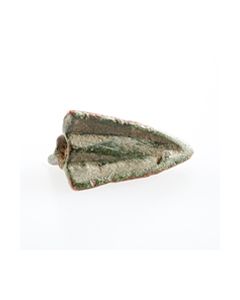 Schön geformte skythische Pfeilspitze
Schön geformte skythische Pfeilspitzeantike Bronzepfeilspitze. Dreiflüglig. Exzellente Erhaltung mit schöner Patina. Typisch für skythische Völker ab ca. 700 v.Chr.
Price: on request Schön geformte skythische Pfeilspitze
Schön geformte skythische Pfeilspitzeantike Bronzepfeilspitze. Dreiflüglig. Exzellente Erhaltung mit schöner Patina. Typisch für skythische Völker ab ca. 700 v.Chr.
Price: on request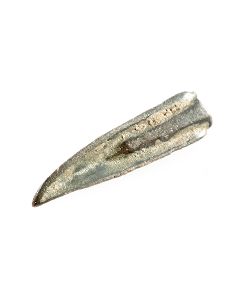 Schön geformte skythische Pfeilspitze
Schön geformte skythische Pfeilspitzeantike Bronzepfeilspitze. Museale Erhaltung mit schöner Patina und Bodenablagerungen
Price: on request Vormünzliche keltische Geldform
Vormünzliche keltische GeldformKeltisches Ringgeld, bestehend aus drei zusammengefügten Einzelringen. Eisenzeit. Aus dem danubischen Raum. 38mm Durchmesser.
Price: on request Keltisches Primitivgeld, Propellerform
Keltisches Primitivgeld, PropellerformAus Bronze, Schwarzmeerregion. Vormünzliche Geldform der Eisenzeit.
Price: on request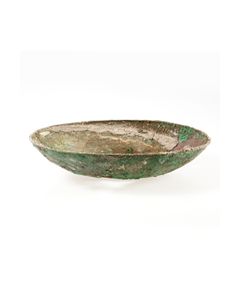 Griechischer Bronzeteller
Griechischer BronzetellerTeller oder Platte aus Bronze. Haushaltsgeschirr. Flache Form mit gleichmäßiger Wölbung, ohne Standfuß. Griechisch, 8. bis 4. Jh. v. Chr., Durchmesser 155 mm.
Price: on request Daunian jug with high handle
Daunian jug with high handleItalic pottery in the subgeometric style. Made around 500 BC in Apulia. Handled vessels of this type are an guiding form in Apulian archaeology.
Price: on request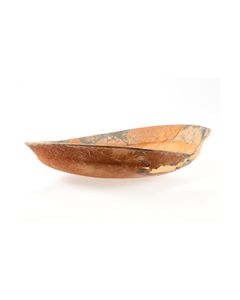 Museale Bronzeschale aus dem 1. Jahrtausend v. Chr.
Museale Bronzeschale aus dem 1. Jahrtausend v. Chr.Begehrtes Statussymbol jener Zeit, gerne in Keramik imitiert. Seltenes, großes Stück. 175mm Durchmesser, mit schöner Patina.
Price: on request Rare imitation of a scarab seal from Sicily
Rare imitation of a scarab seal from SicilySeltene Imitation eines ägyptischen Skarabäussiegels mit eindrucksvoller kräftig-blauer Glasur. 25. bis 26. Dynastie, Übergang von der 3. Zwischenzeit zur Spätzeit. 14mm lang.
Price: on request Large decorated violin bow fibula
Large decorated violin bow fibulaImpressive piece of jewellery because of its size and decoration. From Central Europe, made during Late Bronze Age or Early Iron Age.
Price: on request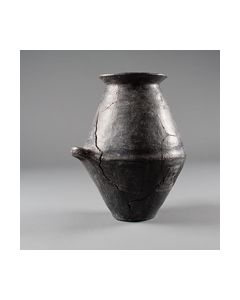 Funerary urn from the Villanova culture - found in Chiusi, Italy
Funerary urn from the Villanova culture - found in Chiusi, ItalyKeramik aus dem 9. Jh. v. Chr., unmittelbar vor der etruskischen Besiedelung. Ritzdekor aus Swastika und anderen geometrischen Elementen. Gefunden in Chiusi, Norditalien.
Price: on request Large Villanova culture krater
Large Villanova culture kraterVery large, impressively preserved object. From an old Dutch private collection.
Price: on request Published etruscan hydria or amphora
Published etruscan hydria or amphora1969 on exhibition in the Stadtsparkasse Gelsenkirchen, published in the exhibition catalogue. Perfectly preserved, from an old German private collection, acquired in the 1970s at Galerie Hermanns, Munich. Coming with an ArtLoss certificate
Price: on request Etruscan Vetulonia type helmet
Etruscan Vetulonia type helmetFrom the possession of New York City antiquities dealer Sumner Healey, who was made famous by Berenice Abbott's scenic photograph from 1936.
€18,000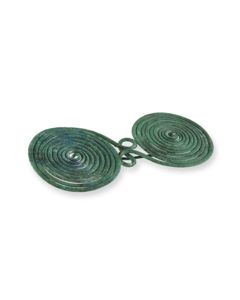 Magnificent spectacle brooch from Greece
Magnificent spectacle brooch from GreeceThe very large bronze brooch was made between the 9th and 6th century BC. It is formed by a single piece of wire. With an old expertise from Nefer Gallery.
€4,700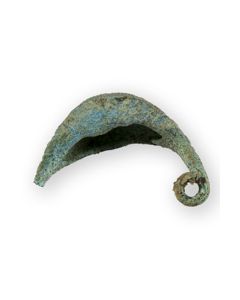 Early Etruscan sanguisuga fibula
Early Etruscan sanguisuga fibulaThe early Etruscan bronze brooch is characterized by its artistically decorated bow. A find from northern Italy.
€180 Early Etruscan sanguisuga fibula
Early Etruscan sanguisuga fibulaThe early Etruscan bronze brooch is characterized by its artistically decorated bow. From the collection of Professor Alder-Kissling.
Price: on request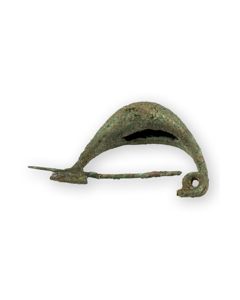 Early Etruscan sanguisuga fibula
Early Etruscan sanguisuga fibulaThe early Etruscan bronze brooch is characterized by its artistically decorated bow. A find from northern Italy.
€325 Early Etruscan sanguisuga fibula
Early Etruscan sanguisuga fibulaThe early Etruscan bronze brooch is characterized by its artistically decorated bow. A find from northern Italy.
€420 Early Etruscan sanguisuga fibula
Early Etruscan sanguisuga fibulaThe early Etruscan bronze brooch is characterized by its artistically decorated bow. A find from northern Italy.
€320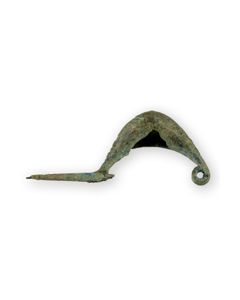 Early Etruscan sanguisuga fibula
Early Etruscan sanguisuga fibulaThe early Etruscan bronze brooch is characterized by its artistically decorated bow. A find from northern Italy.
€310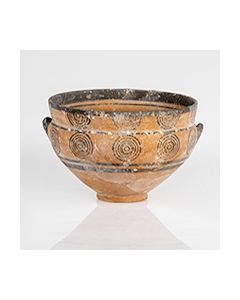 Large cypriot bowl, ex Sotheby's
Large cypriot bowl, ex Sotheby'sDating to the early cypro-archaic period, so-called black-on-red ware II. From an old German private collection, acquired 1970 at Sotheby's. Coming with an ArtLoss certificate.
Price: on request Early Etruscan sanguisuga fibula
Early Etruscan sanguisuga fibulaThe early Etruscan bronze brooch is characterized by its artistically decorated bow. A find from northern Italy.
€350 Villanovan fibula from the Hattatt collection
Villanovan fibula from the Hattatt collectionBronze brooch of the Italic Iron Age. The piece is published in the standard work "Brooches of Antiquity".
Price: on request Lekythos from Toledo Museum collection
Lekythos from Toledo Museum collectionEx collection Prof. G. Olcott, the first Columbia University professor for Roman archeology. Acquired from his estate 1912 by the Toledo Museum (Ohio), in the museum collection until 2017. Found in Apulia.
Price: on request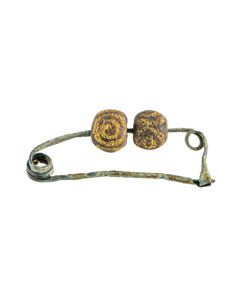 Early Italic brooch decorated with beads
Early Italic brooch decorated with beadsThere rare brooch type from northern Italy is based on predecessors from Greece. The piece is from the famous Richard Hattatt collection and is published in two of his works.
Price: on request

